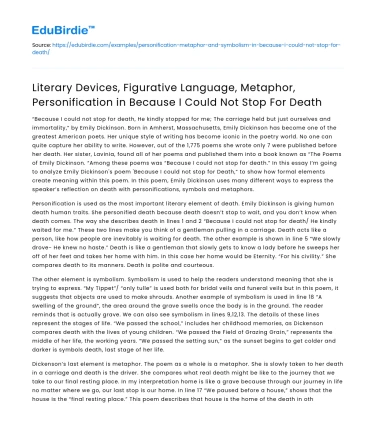“Because I could not stop for death, He kindly stopped for me; The carriage held but just ourselves and immortality,” by Emily Dickinson. Born in Amherst, Massachusetts, Emily Dickinson has become one of the greatest American poets. Her unique style of writing has become iconic in the poetry world. No one can quite capture her ability to write. However, out of the 1,775 poems she wrote only 7 were published before her death. Her sister, Lavinia, found all of her poems and published them into a book known as “The Poems of Emily Dickinson. “Among these poems was “Because I could not stop for death.” In this essay I’m going to analyze Emily Dickinson's poem 'Because I could not stop for Death,” to show how formal elements create meaning within this poem. In this poem, Emily Dickinson uses many different ways to express the speaker’s reflection on death with personifications, symbols and metaphors.
Personification is used as the most important literary element of death. Emily Dickinson is giving human death human traits. She personified death because death doesn’t stop to wait, and you don’t know when death comes. The way she describes death in lines 1 and 2 “Because I could not stop for death/ He kindly waited for me.” These two lines make you think of a gentleman pulling in a carriage. Death acts like a person, like how people are inevitably is waiting for death. The other example is shown in line 5 “We slowly drove- He knew no haste.” Death is like a gentleman that slowly gets to know a lady before he sweeps her off of her feet and takes her home with him. In this case her home would be Eternity. “For his civility.” She compares death to its manners. Death is polite and courteous.
Save your time!
We can take care of your essay
- Proper editing and formatting
- Free revision, title page, and bibliography
- Flexible prices and money-back guarantee
The other element is symbolism. Symbolism is used to help the readers understand meaning that she is trying to express. “My Tippet”/ “only tulle” is used both for bridal veils and funeral veils but in this poem, it suggests that objects are used to make shrouds. Another example of symbolism is used in line 18 “A swelling of the ground”, the area around the grave swells once the body is in the ground. The reader reminds that is actually grave. We can also see symbolism in lines 9,12,13. The details of these lines represent the stages of life. “We passed the school,” includes her childhood memories, as Dickenson compares death with the lives of young children. “We passed the Field of Grazing Grain,” represents the middle of her life, the working years. “We passed the setting sun,” as the sunset begins to get colder and darker is symbols death, last stage of her life.
Dickenson’s last element is metaphor. The poem as a whole is a metaphor. She is slowly taken to her death in a carriage and death is the driver. She compares what real death might be like to the journey that we take to our final resting place. In my interpretation home is like a grave because through our journey in life no matter where we go, our last stop is our home. In line 17 “We paused before a house,” shows that the house is the “final resting place.” This poem describes that house is the home of the death in other word a gravesite which is final destination. The speaker depicts the timeless nature of eternity. It suggests that both death and life are journeys, but death’s journey is free of the busy, chaotic pace of life which we can see in line “Feels shorter than the Day.”
In conclusion, the theme of this poem it’s about death which is natural and there is no way to avoid it. In this poem death is polite and civil. Usually death is portrayed as a cruel and painful experience, but Dickenson represents him as a kind figure. The words create a calm and fearless mood. A connection is the poem to Emily’s life. It seems that she wrote this poem before her death in real life. She expected her death anytime soon. She was calm and understanding just like she sounded in the poem. Emily Dickinson uses death as personification and she also includes many symbols and metaphors. We aren’t always ready for death, but death is ready and waiting for us.






 Stuck on your essay?
Stuck on your essay?

